On the 10th February, 2023 the largest and most comprehensive exhibition of paintings by the Dutch artist Johannes Vermeer opened at The Rijksmuseum in Amsterdam. Paintings have been borrowed from collections in Berlin, London, The Hague, Dublin, Vienna, New York, Washington DC and even The Louvre, Abu Dhabi. Collectively these canvases represent the vast majority of paintings completed by Vermeer during his short life. There will be a total of 28 Vermeer paintings on display in Amsterdam, from now until June, 2023.
Just a few weeks ago I wrote that ‘the chance to see so many Vermeer masterpieces in the same place is a truly unique opportunity and advance ticket sales at a cost of € 30 per person are proving very satisfactory for the managers and staff of the Rijksmuseum’. Two weeks later the show is a complete sell out. Tickets for all dates up to the end of the show (10th June) have been sold. In fact the sale of tickets took the Rijksmuseum by surprise – they are busy trying to make more tickets available and have promised an update on 6th March. The new batch of tickets has now also sold out.
The question is, why is a Dutch 17th century artist attracting so much attention and interest more than three centuries after his death. The answer is multi-layered, just like the brush strokes and textures of his paintings. Let’s investigate further the paintings of Vermeer……


The Little Street ‘Het Straatje’ (left) and The Milk Maid (right) – both paintings by Johannes Vermeer c. 1657-1658
JOHANNES VERMEER was born in the small city of Delft in 1632 where his father worked as an art dealer and inn keeper. He married at 21 and proceeded to have fifteen children with his Catholic wife Catharina. The couple and their numerous children lived with Catharina’s mother in the house above (left), painted by Vermeer in about 1657. The painting known as ‘The Little Street’ is one of Vermeer’s most famous paintings. The photographic realism of this painting is quite exceptional. When I look at the painting I can almost touch the red brick of the facade. I can hear the mopping or brushing of the yard at the side of the house. Whilst the yellow staining of the whitewashed wall of the neighbouring house suggests a damp, possibly rancid odour. Recent research identified Vermeer’s neighbour (in the house next door) as an aunt who was actually a tripe-seller. The alleyway at the side of the house was named ‘Penspoort’ or Tripe Gate. The gutter in the paving was for draining foul liquids and water, associated with tripe preparation, into the canal adjacent to the house. So it’s quite possible that the yellow staining came from the tripe residue being sluiced out of the alley every day. It’s also very possible that it smelt pretty putrid.
The painting on the right is ‘The Milk Maid’ dated 1658. This is one of several dozen household scenes painted by Vermeer. His use of colour in his paintings is quite exceptional, he was known for using very expensive pigments. Blue was one of the most costly and he’s used it liberally in the table covering and apron of the woman pouring the milk. The painting is filled with detail, bread baskets on the table and wall, a copper cauldron, a terracotta jug and bowl. Every item painted in great detail with, once again, an almost photographic quality to it. Vermeer’s skill is that he introduces the viewer to 17th century Delft, to ordinary people and ordinary lives being lived 350 years ago. The young woman is pouring the milk into the bowl, I can almost hear the liquid splashing into the terracotta pot. Somehow across the centuries I can hear the voices of Vermeer’s subjects. I can savour the aroma of freshly baked bread set out on the table ready for lunch. I have stepped into the painting with the young woman and her milk jug. I can almost touch the table laden with milk and fresh bread.
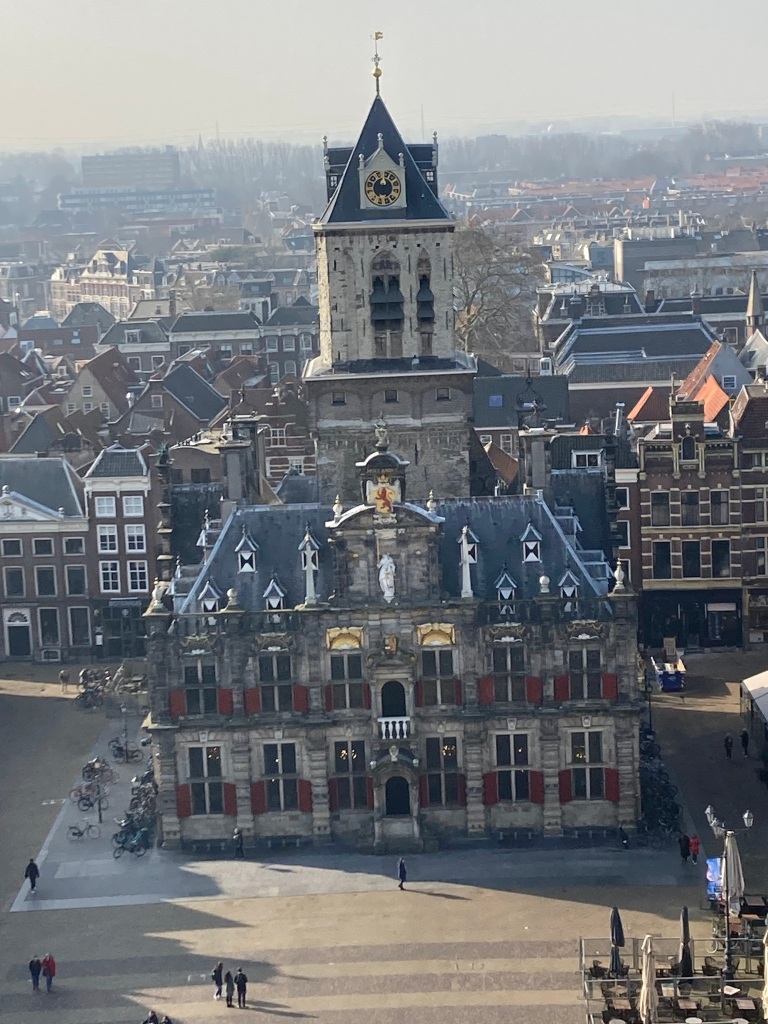
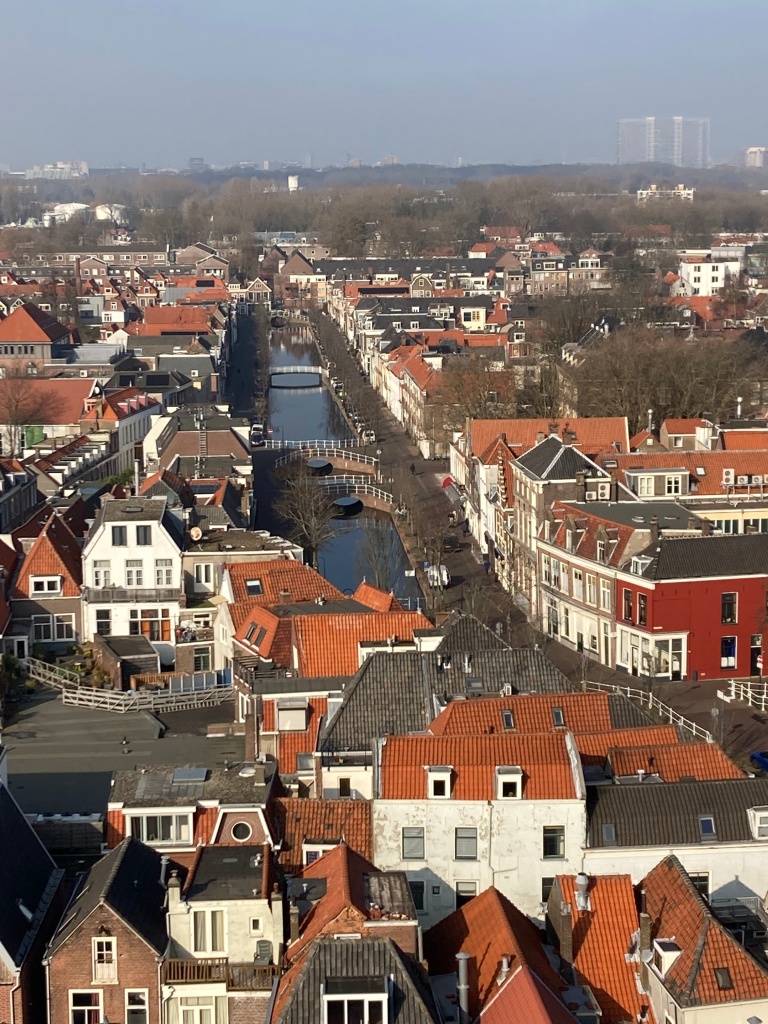


Delft – February, 2023 – one of the most scenic and typically Dutch towns in the Netherlands
DELFT is a charming small city with a beautiful main square and delightful canals lined with typical Dutch town houses. It has always been a wealthy city, an important market town and trading centre for textiles, grain and beer. Fortunately for Delft the Dutch East India Company set up an important office here in the mid-17th century. This was about the same time that the same company introduced a new and beautiful blue and white glazed china into Holland from the East. No time was wasted in setting up two porcelain-making factories producing the famous ‘Delft Blue’ china that remains in production to this very day and is still enormously popular. In fact the Royal Delft China Factory was established in 1653 and was opening its doors to the world just as the young artist Vermeer was becoming established as a painter. It is easy to imagine the small city of Delft, with its bustling market square, filled with wealthy merchants and traders. Delft was a perfect place for a painter like Vermeer to ply his trade.
ART – In creative circles the perceived wisdom is to focus on what you know. Certainly Vermeer took this straight forward principle very seriously. He painted the people, places and scenes that he saw every day in his city. He painted a dramatic cityscape of his home town of Delft (below) complete with barges and boats, cranes and city gates. Vermeer was masterful in his use of colour, look at the brooding sky with the menacing clouds hinting at rain. Admire the calm, almost surreal smoothness of the water in the foreground. One can almost hear the conversation that the two women are having on the riverbank. To the left a family group stands by a barge perhaps they are discussing recent events in the city. Meanwhile the buildings of the city are reflected stoically in the still, dark waters of the River Schie. There’s something profound and important about this painting. It pulls the viewer in, as if there’s a magnetic field summoning your attention. When Marcel Proust saw this painting in The Hague he announced, in typically melodramatic style,
..’Ever since I saw the View of Delft in the museum in The Hague, I have known that I had seen the most beautiful painting in the world…’
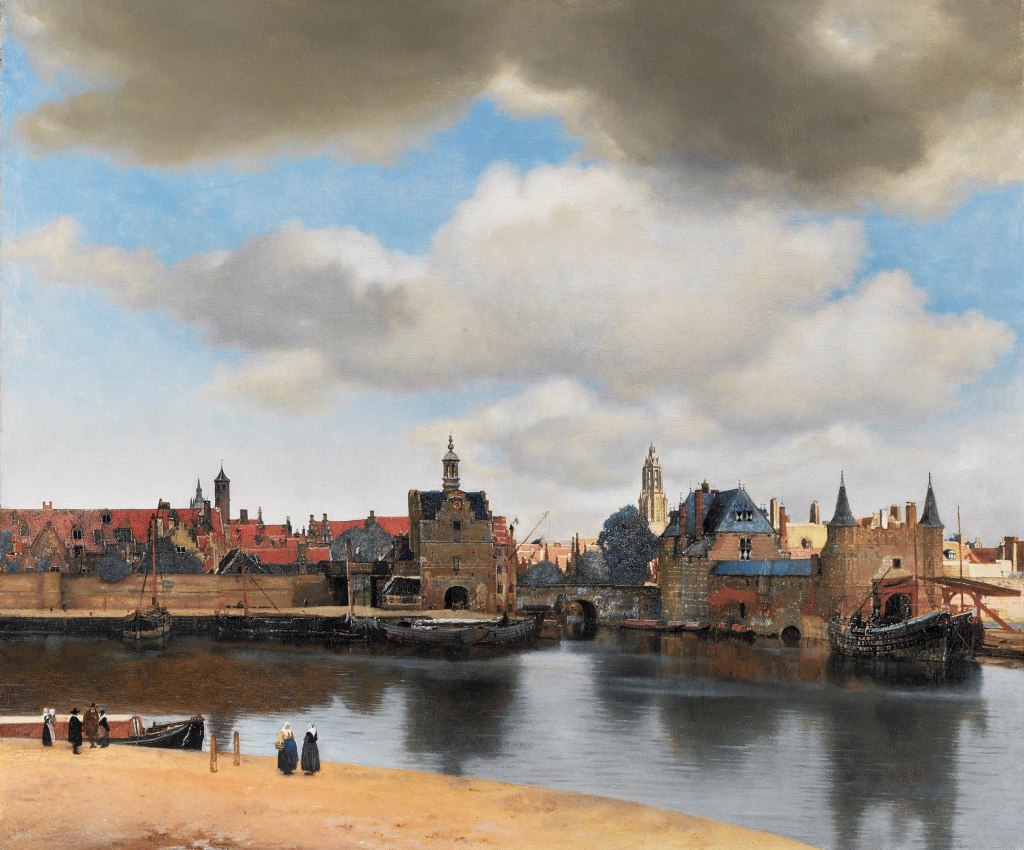
Vermeer – View of Delft – painted c. 1660. This painting can usually be seen in the Mauritshuis, The Hague
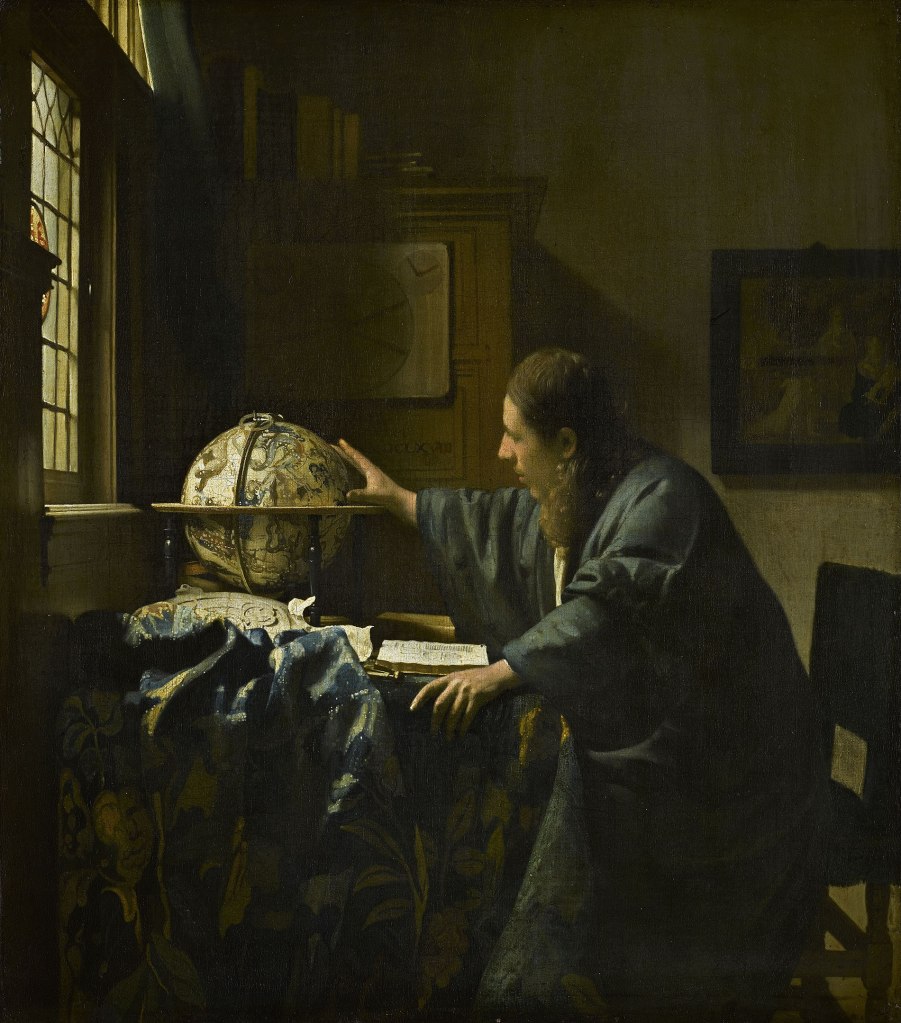

The two paintings above – The Astronomer (left) and The Geographer (right) have many similarities.
VERMEER often painted interior scenes using a very similar arrangement of furniture and lighting. In the case of the two paintings above, the light comes in from the window illuminating the man’s face and hands. In the ‘Astronomer’ painting, the overall mood is dark, shadowy and mysterious. The Astronomer rotates a celestial global, pondering its secrets, whilst a book lies open on the table. The painting is richly detailed, a thick tapestry or tablecloth is draped over the desk. The cupboard, chair and painting on the wall offer us a view into an ordinary, domestic setting.
Meanwhile the ‘Geographer’ painting (on the right) is more brightly lit, the geographer is deep in thought. There is a globe on the top of the cupboard and maps on the floor. The lilies on the tablecloth in the first picture now appear on the upholstery of the chair in the second picture. Both paintings are textured and detailed, the objects placed in each room can be read and examined to complete our understanding of the scene. Vermeer gives the viewer an opportunity to enter into the world of the Astronomer and the Geographer as they go about their daily work. We can almost sit and think with them. Perhaps Vermeer’s greatest skill was his ability to show the viewer an intimate version of daily life in Delft in the 17th century.
However, Vermeer’s skill wasn’t limited to photographic-style reproduction of objects and interiors, he was also a master of colour, light and depth. The painting below known as ‘The Art of Painting’ is a painting within a painting. The young woman poses as the artist captures her vibrant, blue head-dress. Light comes in from the window, hidden from view by a thick, woven curtain. The young woman gazes downwards. Her face is beautifully and subtly lit. Vermeer plays with light and dark, using shadow to give depth and texture to the map hanging on the wall of the room. He does the same thing with the curtain, pulled back in folds of heavy, dense fabric, alternating light and dark in the drapes of the material. The colour palette in the painting (excluding the painter himself and the floor) is made up of shades of blue, gold, brown, grey and white. Vermeer is well known for his use of colour in his paintings. He was especially fond of blue shades that came from the expensive lapis lazuli stone which was ground down to create a very expensive pigment. In the canvas below Vermeer uses varying shades of blue in the young woman’s gown, the richly patterned curtain and the luxurious velvet shawl draped on the table.
The painter himself is expensively dressed in a black tunic with a cream shirt underneath. His stockings are red providing a splash of colour and individuality to the artist at work. He wears a typical artist’s cap. Once again Vermeer’s skill allows the viewer to enter the painting. This time I can imagine myself stood in the doorway watching this scene, perhaps carrying a tray, ready to offer refreshments to the young woman and the great artist. Vermeer’s painting style gives me the opportunity to experience life in Delft in the 1660s – to step across the threshold, across the centuries, into another dimension, the world of Holland’s ‘Golden Age’.

Vermeer creates a rich and evocative scene in ‘The Art of Painting’
There’s another element to Vermeer’s paintings that make them so intensely interesting. It’s his use of highlighting small details in each canvas, so that they almost sparkle or glitter, encouraging the viewer to look more closely. In the case of ‘The Art of Painting’ you can see this technique in the brass studs that line the leather seat in the foreground. He uses the same technique on the sleeves of the painter’s shirt. Finally, a beady-eyed observer might notice the hint of a pearl earring, reflecting the light on the young girl’s left ear. These details may seem very small and yet they enrich and elevate Vermeer’s work to masterpiece level. This brings me to the most famous painting in the Vermeer Exhibition at the Rijksmuseum and that is, of course, The Girl with the Pearl Earring.
This painting is an extraordinary amalgamation of consummate skill and complexity combined with an apparent simplicity. Vermeer’s use of a dark background and an illuminated, brightly-lit foreground, gives the young woman’s face depth and clarity. Highlighting of colour on the lips, eyes and the pearl earring enliven the painting. The folding of the blue and gold fabric on the head is textured with light and dark. This is mirrored in the tunic which is a heavier fabric, reflecting both light and shade and giving movement to the whole composition. The Girl with the Pearl Earring is a masterpiece that has inspired and influenced many. Last year (February 2022) at the Venice Carnival I was delighted to meet a young woman dressed as Vermeer’s heroine (photos below). Once again the deceptively simple construction of the painting belies the complexity that lies within. An apparently simple carnival costume had taken months to create and perfect. And yet it was the star of the show as she strolled through the colonnades of St Mark’s Square. I absolutely loved the reinterpretation of The Girl with the Pearl Earring in Venice, what creativity and style!

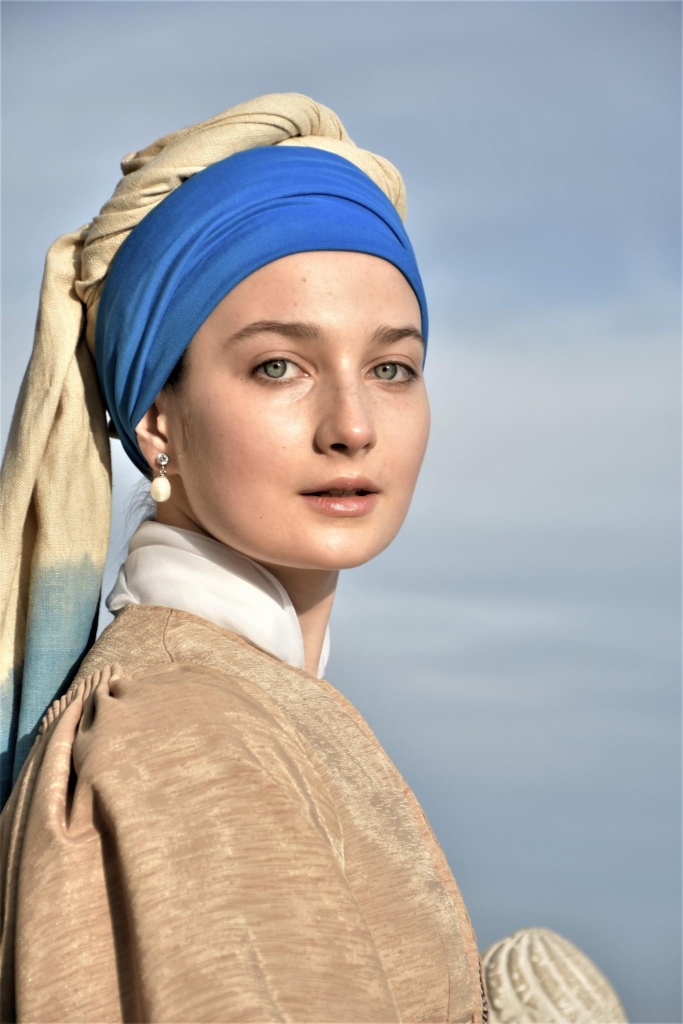
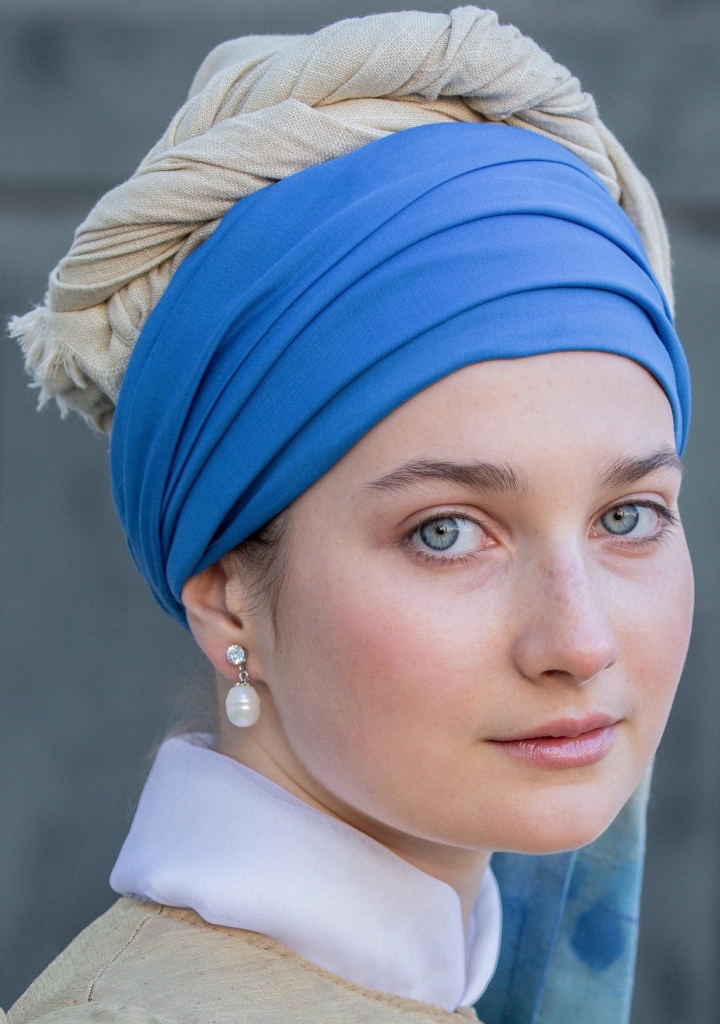
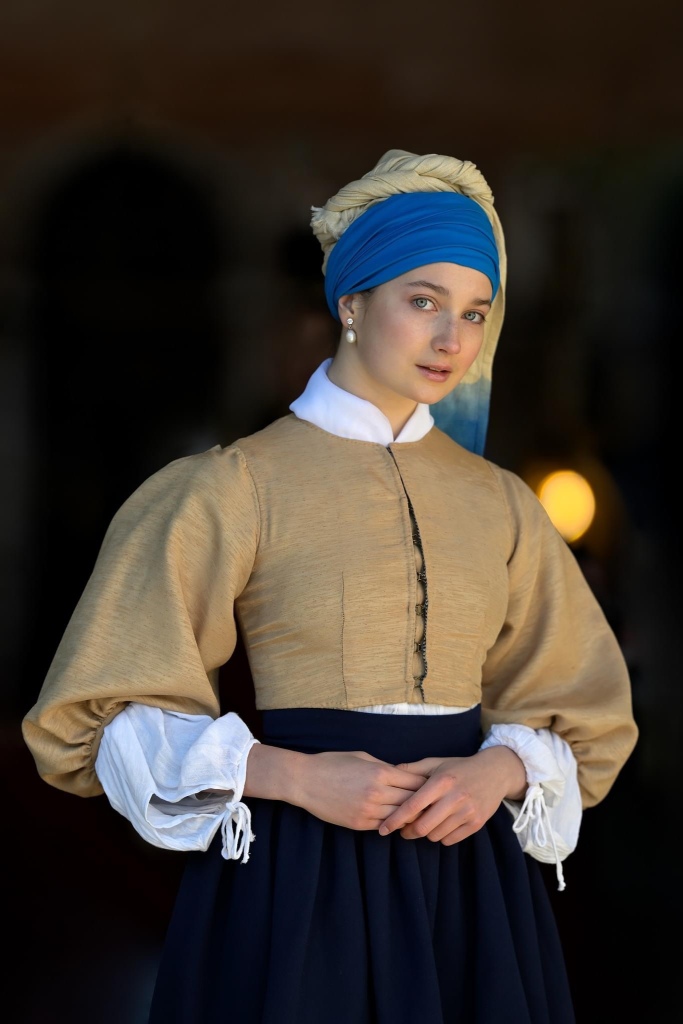
There’s a final ironic twist to the Vermeer story. The irony is that Vermeer’s home town of Delft does not possess a single Vermeer painting, despite the painter living and working in the city for his entire life. In normal circumstances there are two Vermeer paintings hanging in the Mauritshuis in The Hague, just twenty minutes from Delft. There’s a Vermeer Centrum in Delft which houses reproduction images of all the great man’s works, but not an original to be seen. As our transatlantic cousins would say ‘Go figure’….
The Vermeer show opened on 10th February to rave reviews. I haven’t actually managed to get tickets yet, although I’m working on it. Meanwhile ‘The Girl with the Pearl Earring’ will be back in her usual home at The Mauritshuis in The Hague at the end of March. So even if I can’t get to see the Vermeer show in Amsterdam I’ll head to The Hague in April to admire the girl, the outfit and that quite incredible pearl earring.
Notes:
- Johannes Vermeer lived and worked in Delft, Netherlands. Born: 1632 – he died after a short illness, aged 43 in 1675
- The painting Delft skyline (1660) was probably an idealised view of Delft. A couple of years earlier, in 1654 ‘The Great Thunderclap of Delft (a huge explosion of gun-powder) had destroyed many of the city’s buildings.
- The ‘View of Delft’ by Vermeer has been exhibited at The Mauritshuis, The Hague since 1822 as part of the ‘Dutch Royal Cabinet of Paintings’. It is currently on display at The Rijksmuseum until June, 2023 as part of the Vermeer Exhibition.
- Generally speaking the ‘Girl with the Pearl Earring’ also hangs in the Mauritshuis, she too is currently in Amsterdam at The Rijksmuseum as part of the Vermeer Exhibition. However she will be back in The Hague at the end of March, 2023 to coincide with the start of the tourist season in Holland.
- www.mauritshuis.nl
- www.rijksmuseum.nl
- IMPORTANT – The Vermeer Centrum in Delft has reproductions of all Vermeer’s works in their collection, however they are not originals, they are reproductions. Nevertheless the Centrum is worth a visit to learn about Vermeer, his life and his painting style. www.vermeerdelft.nl
- Delft is also well worth a visit, it is charming, with beautiful houses and numerous canals. www.delft.com
- Funnily enough my son William lives in Delft. He went there to university eight years ago and he’s been there every since.
- There is some discussion as to whether Vermeer used a Camera Obscura – this was a device that reflected light through a small aperture onto a blank canvas or screen. It enabled painters to reproduce images and scenes in precise detail.
- The Guardian review of Vermeer Exhibition – is glowing: The Guardian – 12 Feb, 2023 – Vermeer review
- General: In 2015, archival research based on the city’s quay dues register, which gives detailed measurements of all houses and passageways along the canals of Delft at the time, resulted in the conclusion that the site of Vermeer’s house was on the Vlamingstraat, a street with a narrow canal, at the present-day numbers 40 and 42.The research also found that the property on the right in the painting ‘Little Street’ belonged to Vermeer’s aunt, Ariaentgen Claes van der Minne. She had a business selling tripe, and the passageway beside the house was known as the Penspoort, or Tripe Gate. Vermeer’s mother and sister also lived on the same canal, diagonally opposite. Source: Rijksmuseum publication (2015)
STOP PRESS – new tickets just released. Tickets available (mostly evening visits) from now until end of June. Strongly recommended. www.rijksmuseum.nl
- Written: 15th February, 2023
- Updated: 8th March, 2023
- Other exceptional art in Europe in 2023: Vittore Carpaccio at Palazzo Ducale starts 18th March
- https://palazzoducale.visitmuve.it/en/mostre-en/mostre-in-corso-en/vittore-carpaccio-paintings-and-drawings/2023/02/22819/carpaccio-2023/
16th March 2023
10th October 2023
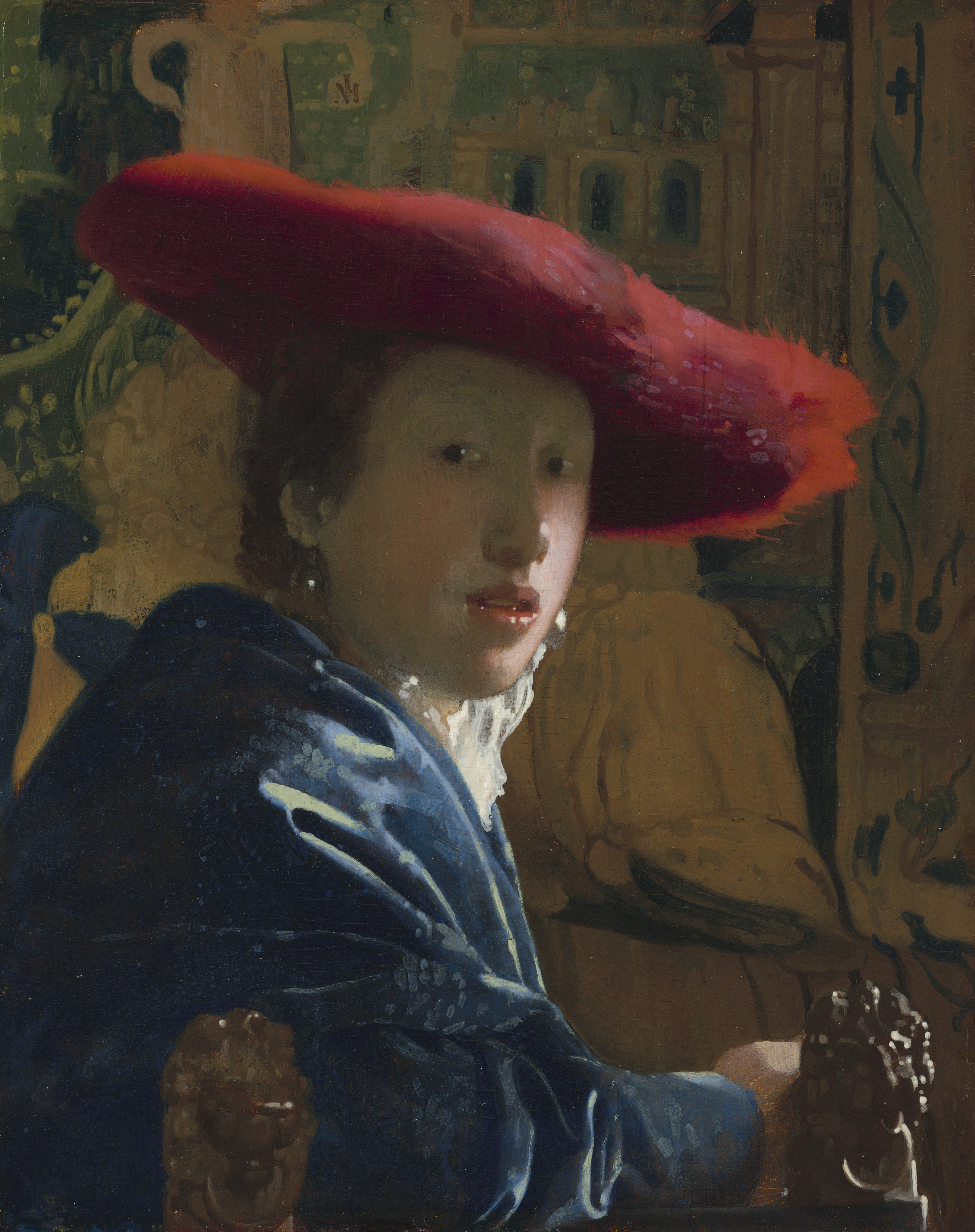

Thank you for your very enjoyable post. The point about writing letters is very well made and an important part of communication in the 17th century. The Mauritius is in Den Haag (The Hague) and The Girl with the Pearl earring is scheduled to return there on 31st March (however this might change).
Also The Rijksmuseum has released some additional tickets for The Vermeer show (available since 10th March). They are all evening slots.
Happy writing and thank you for sharing your post! Janet @educated-traveller
LikeLike
Thank you for the link and nicely written article. You are so right, letter writing was an important form of communication in the 17th century.
LikeLike
Definitely an art historian!
LikeLiked by 1 person
Fabulous post Janet! We have been trying unsuccessfully to obtain tickets to the exhibit- hoping for end of May. Worth a trip over! Hope all is well.
LikeLiked by 1 person
Lovely and beautifully presented story. Thank you. And, the Venezia add is a wonderful enrichment.
LikeLiked by 1 person
many thanks – a very kind comment.
LikeLiked by 1 person
Another masterpiece of illumination (literally), Janet – congratulations and thank you!
(But you don’t say whether you think that the Pearl ear-ring was a real pearl or an imitation glass bauble, as Pieter Roelofs thought…..?!)
John
LikeLiked by 1 person